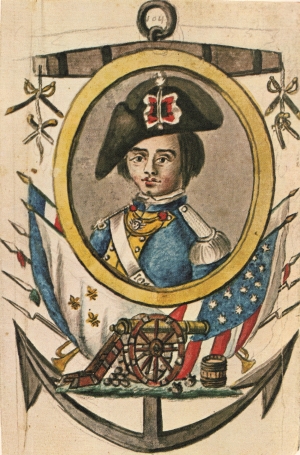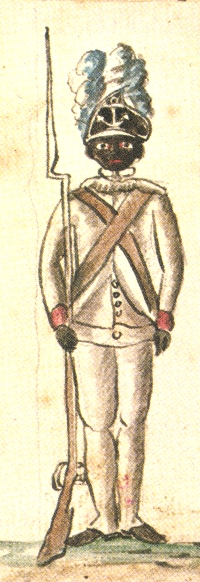|
Jean-Baptiste Antoine de Verger (1762-1851), a sublieutenant in the Royal Deux-Ponts regiment that took part in the 14 October 1781 assault on Redoubt 9 at Yorktown, wrote a journal recording his observations while serving with Rochambeau's expedition in America. The journal has been translated by Howard C. Rice and was published with edited comments/notes in The American Campaigns of Rochambeau's Army, 1780, 1781, 1782, 1783, translated and edited by Howard C. Rice, Jr. and Anne S.K. Brown, Volume I The Journals of Clermont � Cr�vecoeur, Verger, and Berthier (Princenton and Brown Universities, NY and RI, 1972.). According to the Mr. Rice, Verger began constructing his journal in December 1781 and ended doing so in January 1784. The portion of Mr. Rice's translation, from pp.141-143 of The American Campaigns of Rochambeau's Army, is quoted below.
|
14-15 October. Major general: Baron de Viom�nil. Brigadier: M. de Custine. Regiments: G�tinais, Royal Deux-Ponts. Auxiliaries: grenadiers of the Saintonge Regiment; chasseurs of the Bourbonnais, Agenois, and Soissonnais regiments. Night work party: 800 men.
The attack ordered on the two advanced redoubts of the enemy, one resting on the river, the other on its left, was executed at nightfall. The American light infantry, supported by two of their trench battalions, under the command of the Marquis de La Fayette, attacked the river redoubt [British No. 10] and captured it at bayonet point with the loss of 4 officers wounded and 20 men killed or wounded.
The French troops were ordered to attack the other redoubt [British No. 9]. They debouched from the right flank of the American 5-gun battery and were posted in the following order: the grenadiers and chasseur companies of the G�tinais [76] and Royal DeuxPonts regiments, commanded by Comte Guillaume de Deux-Ponts, second colonel of the latter, and Lieutenant Colonel de l'Estrade of the G�tinais; the first battalion of the G�tinais and the auxiliaries (grenadiers and chasseurs of the Soissonnais Regiment assigned to make a diversion from the left of our grand approach). The latter division, under the command of M. de Rostaing, colonel of the G�tinais Regiment, was in support. The overall commander was the Baron de Viom�nil, who debouched with the troops and led them in perfect order and absolute silence.
The enemy discovered the column early and opened a very lively musket fire upon it. We found their abatis in far better condition than we had anticipated, since much of our artillery had been battering the redoubt for several days. Ignoring the enemy fire and slashing those that resisted with their axes, our pioneers had opened passages for us through which the grenadiers and chasseurs of the Royal Deux-Ponts and G�tinais regiments entered the fosses together with the aforementioned pioneers, who were still obliged to cut through several palisades to open the fraises of the redoubt. These same grenadiers and chasseurs took advantage of the openings to mount the parapet, where they formed up and soon forced the surviving enemies to surrender. Several, wishing to continue the fight with bayonets, paid with their lives.
We captured 3 officers and 40 men, after counting 18 dead. Another 120, under a lieutenant colonel, escaped. During the attack our loss in officers and men was about 80 killed or wounded.[77] The enemy at once commenced a lively cannonade on the redoubt we had just captured, killing and wounding many men.
The moment the redoubt was taken, the men cried "Vive le Roi!" which was echoed along our whole line. This the English took to be the signal for a general assault and rained on us a volley of musketry accompanied by quantities of bombs and shells from all their redoubts and batteries. Once the redoubt was in our hands, 500 workmen debouched from the right of the second parallel to prolong it to the redoubt. American workmen continued this parallel between the two redoubts and opened a communication between the first parallel running from the right between their grand battery and their first redoubt to the one they had just captured.
All these works were pushed forward with the greatest zest and were well advanced by daybreak. The feint ordered at the left of our works was pressed home a little too enthusiastically by M. de Custine who came to within 30 paces of the redoubts and lost a lot of men. [78] At nightfall the enemy's attention had also been attracted to the head of the river by a feint executed without loss by the Touraine Regiment.
Two hundred night workmen were employed in continuing the work on the batteries, and 100 others in perfecting communications in all our works of the preceding nights.
The enemy kept up a fairly heavy fire of bombs and howitzers on our works, which interfered with our workmen. The Bourbonnais Regiment entered the trench at ten in the evening to reinforce it in case the enemy should make a sally.
Killed: 46. Wounded: 68. At the grand approach the following officers were wounded: Comte Guillaume de Deux-Ponts; Chevalier de Lameth; MM. de Sireuil and Berthelot, captains in the G�tinais Regiment [79] M. de Sillegue, sublieutenant in the same; M. de Lutzow, lieutenant in the Royal Deux-Ponts Regiment.
|
|
76. "The grenadiers of the regiment of G�tinais, which had been formed out of that of Auvergne, were to lead the attack. . . . I said to them, `Mes enfants, if I should want you this night, I hope that you have not forgotten that we have served together in that brave regiment of Auvergne Sans tache, an honorable name that it has deserved ever since its creation.' They answered that, if I would promise to have their name restored to them, they would suffer themselves to be killed-even to the last man. They kept their word, charged like lions, and lost one-third of their number. . . ." Rochambeau (2), I, 294. The General also kept his word. In the Etat militaire for 1783 is the following note: "This [Eighteenth Royal Auvergne] Regiment . . . , known by the name of G�tinais, has resumed that of Auvergne by Ordinance of II July 1782." The newspaper published at Le Cap Fran�ais, Affiches Am�ricaines, 5 March 1783, notes that the royal ordinance was read to the regiment in a special ceremony held there on 22 February. [Return to main text.]
77. "The cause of the great loss sustained by the French troops in comparison with that of the Americans in storming their respective redoubts, was that the troops when they came to the abattis, removed a part of it with their hands and leaped over the remainder. The French troops, on coming up to theirs, waited until pioneers had cut away the abattis secundum artem, which exposed them longer to the galling fire of the enemy." James Thacher, Military Journal (Boston, 1823), p. 342n. An abatis is an obstruction made of felled trees sharpened ends are pointed towards the invader. See Profile of Yorktown Fortifications," Vol. 11, No. 100. [Return to main text.]
78. Von Closen reports that Custine got drunk and made his feint attack, ordered for half past seven, an hour late "when all was quiet," losing 9 chasseurs of the Soissonnais and drawing fire from the British, who supposed the attack was being renewed. "He got off with 24 hours' arrest and many jests." Von Closen, pp. 149-150. [Return to main text.]
79. Both Sireuil and Berthelot died later of their wounds. Dawson, Fran�ais Morts aux Etats-Unis, p. 39. [Return to main text.]
|

